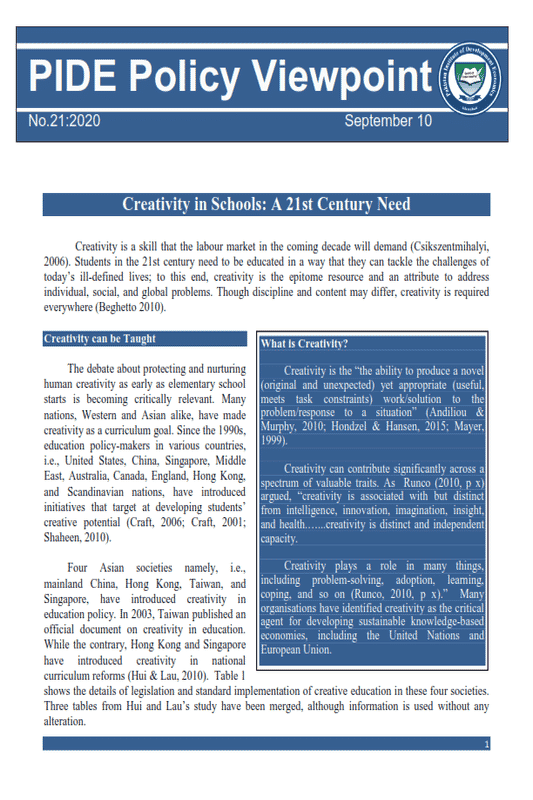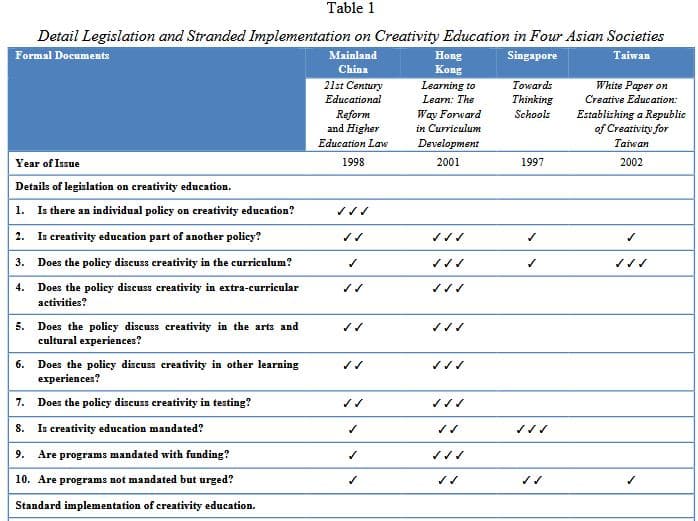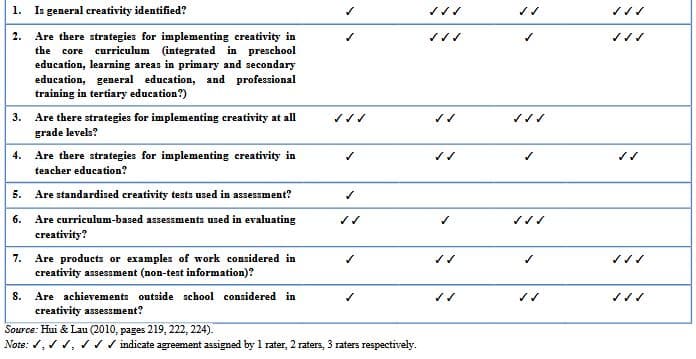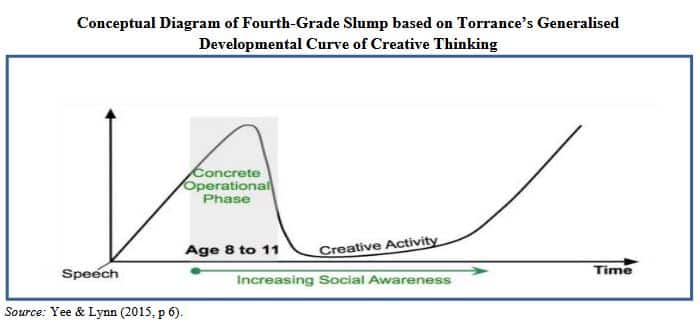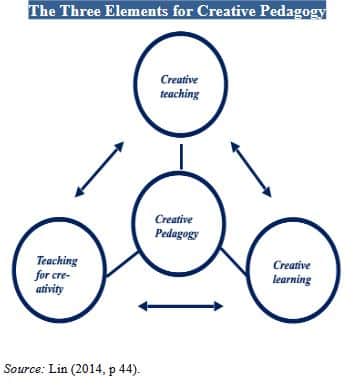
Pakistan Institute of Development Economics
- Home
Our Portals
MenuMenuMenuMenuMenuMenuMenu - ResearchMenuMenuMenuMenuMenuMenuMenu
- Discourse
- The PDR
- Our Researchers
- Academics
- Degree Verification
- Thesis Portal
- Our Portals
Creativity In Schools: A 21st Century Need (PIDE Policy Viewpoint 21:2020)
Creativity in Schools: A 21st Century Need
Creativity is a skill that the labour market in the coming decade will demand (Csikszentmihalyi, 2006). Students in the 21st century need to be educated in a way that they can tackle the challenges of today’s ill-defined lives; to this end, creativity is the epitome resource and an attribute to address individual, social, and global problems. Though discipline and content may differ, creativity is required everywhere (Beghetto, 2010).
Creativity can be Taught
The debate about protecting and nurturing human creativity as early as elementary school starts is becoming critically relevant. Many nations, Western and Asian alike, have made creativity as a curriculum goal. Since the 1990s, education policy-makers in various countries, i.e., United States, China, Singapore, Middle East, Australia, Canada, England, Hong Kong, and Scandinavian nations, have introduced initiatives that target at developing students’ creative potential (Craft, 2006; Craft, 2001; Shaheen, 2010).
Four Asian societies namely, i.e., mainland China, Hong Kong, Taiwan, and Singapore, have introduced creativity in education policy. In 2003, Taiwan published an official document on creativity in education. While the contrary, Hong Kong and Singapore have introduced creativity in national curriculum reforms (Hui & Lau, 2010). Table 1 shows the details of legislation and standard implementation of creative education in these four societies. Three tables from Hui and Lau’s study have been merged, although information is used without any alteration.
| What is Creativity? Creativity is the “the ability to produce a novel (original and unexpected) yet appropriate (useful, meets task constraints) work/solution to the problem/response to a situation” (Andiliou & Murphy, 2010; Hondzel & Hansen, 2015; Mayer, 1999). Creativity can contribute significantly across a spectrum of valuable traits. As Runco (2010, p. x) argued, “creativity is associated with but distinct from intelligence, innovation, imagination, insight, and health.……creativity is distinct and independent capacity. Creativity plays a role in many things, including problem-solving, adoption, learning, coping, and so on (Runco, 2010, p. x).” Many organisations have identified creativity as the critical agent for developing sustainable knowledge-based economies, including the United Nations and European Union. |
The 4th-grade Slump
Researchers who worked on the classroom environments have described the classroom’s classical image as an act where individual teachers standing in front of students, conveying information to be copied and recited. In 1950, Guilford discussed creative thinking among school-age children as it is severely discouraged in classrooms. Almost after a decade, Torrance endorsed his concerns by reporting his studies with first and 2nd-grade students. Results suggest that children with improvised thinking have been subjected to such a classroom environment that would eliminate fantasy from too early (Beghetto, 2010).
Torrance documented several longitudinal studies and came with the term “fourth-grade slump,” a shape decline in divergent thinking in almost half of the children (Beghetto, 2010). All creative thinking abilities begin declining either at the end of third grade or at the beginning of the fourth grade (child’s age 8 to 11 years old) (Torrance, 1967). From the onset of speech, child creativity increases until the age of 9 years, followed by a trough period. This rapid slump period matches when the child enters a ‘concrete operational phase’ (Yee & Lynn, 2015). The concrete operational phase in Piaget’s cognitive development theory is when a child starts using logic in concrete ways. The fourth-grade slump in a conceptual drawing is given below.
Strategies for Teaching Creatively
Research shows that creativity could be increased by education and training among children (Ergen & Akyol, 2012; Mirzaie, Hamidi & Anaraki, 2009; Zahra, Yusooff, & Hasim, 2013). For example, a study examines the effectiveness of creative training among preschool students through brainstorming, web link, storytelling, and role-plays (Zahra, Yusooff, & Hasim, 2013). Results show a significant positive effect of creative training on divergent thinking skills (i.e., fluency, flexibility, elaboration, and originality) among students.
Teachers’ beliefs about a supportive classroom environment to nurture creativity are crucial. Research shows that teachers who believe that creative thinking can be nurtured and developed in a classroom environment described a classroom’s core features as open, flexible, unconventional, and student-centred (Andiliou & Murphy, 2010).
The possibilities to nurture creativity in classrooms are limitless; however, below are the few examples taken from Newton’s book Creativity for a new curriculum: 5-11 (Newton, 2012). For example, how to nurture creativity in Geography class? Newton suggests that since Geography seeks to understand people’s interaction and the environment, children could be assigned environmentalists, town planners, travel book writers, or explorers. Engaging maybe incorporate a combination of roles. In history, nurturing creativity could mean finding things out or solving problems and not about spinning narratives. Students must be given space to break free from the traditional way of doing things like mathematics, where the sound knowledge base is required. That means showing flexibility in one’s approach to problem-solving where the creativity lies (Newton, 2012).
| Big ‘C’ and little ‘c’ The literature on creativity differentiates creativity between “big C” and “little c.” The former metaphor for creativity refers to the inventions that are grand or change human lives in one way or another. The “big C” is a process where something historically or socially novel emerges or happens. The “little c” is everyday creativity or possibility thinking, where output may not be necessarily significant for society but only to the individual (Craft, 2001; Lin, 2011; Moran, 2010). The ideas produced by students may not be regarded as creative joints or useful in the long run, but if the concept is new to them, it is considered little ‘c’ creativity. In the education of context, the target will be to cultivate and encourage the little c creativity among students. Big C = refers to creative ideas/products that are original/unexpected historically to the world. Little c = refers to everyday creative ideas that are new to the individuals. |
| Elements to Nurture Creativity among Children · Asking questions. · Pedagogies based on the play. · Immersion and connection making. · Being original and imaginative. · Innovation. · Risk-taking. · Determination. Source: Cremin, Burnard, and Craft (2006). |
Creative Pedagogies Entering Classrooms Everywhere
It is challenging to determine how exactly to implement creativity as a curriculum goal in a classroom setting. Research suggests a shift in pedagogical practices (Lin, 2014). Lin came up with a framework for creativity pedagogy. The framework provides a holistic view of pedagogical principles for fostering everyday creativity and seeks to facilitate the possibility of thinking.
The creative pedagogy model includes three interrelated elements: creative teaching, teaching for creativity, and creative learning. These three components complement one another and establish a shared and reflective teaching and learning process, rather than traditional pedagogical methods in which teaching and learning are two parallel processes. Creative teaching and teaching for creativity are interconnected and necessary processes (Lin, 2014).
 Barriers to Creativity in Classrooms
Barriers to Creativity in Classrooms
Nurturing and facilitating creativity and creative potentials in a classroom setting could be challenging and problematic in some aspects. Here are the three main barriers that can suppress creativity in the classroom (Beghtto, 2010).
- Convergent teaching practices.
- Teachers’ beliefs and attitudes about creativity.
- The motivational environment & students’ beliefs about their creativity.
| Elements for Creative Pedagogy Creative teaching involves imaginative, dyna-mic, and innovative approaches to make learning exciting and compelling. Moreover, creative teaching is considered similar to “teaching as art” and “teaching as improvisational performance”. Teaching for creativity aims to develop learners’ creative capacities and facilitates learners’ agency and engagement through various means, such as devising learning strategies and exploring new possibilities. Teaching for creativity aims to stimulate learners’ curiosity, motivation, problem-solving, and appreciation for creative ideas, to name a few. Pragmatic approaches and pedagogical principles such as standing back, profiling learner agency, and creating time and space are considered the core methods of developing students’ creative capacities. Creative learning focuses on children’s spon-taneous learning process. Creative learning calls for active and innovative engagement instead of passively accepting ideas by an authority (e.g., teachers, books). In creative learning, children learn through questioning, researching, exploring, investigating, and even playing aimlessly. Source: Lin (2014). |
| “We show that supporting creativity is not yet another experience to be added into an already over-crowded day. Rather, it is a way of thinking and working that can be developed and used in any subject area to enhance learning in that subject (Newton 2012, p .1)”. |
| 1- Convergent Teaching Practices The convergent teaching approach is based on a talk design called “IRE pattern.” IRE stands for the initiate, respond, and evaluate. Traditionally, IRE is the standard method used in classrooms by teachers. Most children are subjected to the IRE pattern as soon as they have been in preschool/nursery. Resultantly, students learn their role by the time they are finished with merely a few years of formal schooling. The IRE goes like this; the first teacher teaches, students wait for the teacher to ask questions, students raise their hands and quietly wait on the teacher to call on them, students share their response (matching between what they think and what teachers expect to hear), and finally, teachers tell whether their response is correct or appropriate. The approach’s biggest downfall is that unexpected or creative response is often not welcome or dismissed in the classroom. Research shows that even the prospective teachers desired expected ideas. Unique or unexpected ideas are viewed as potential or intentional distractions. Indeed, the students’ unexpected ideas do not mean creative ideas all the time, but unexpected ideas may lead to creative ideas (Beghtto, 2010). |
| 2- Teachers beliefs about creativity Mostly teachers in a classroom setting consider creativity equivalent to nonconformity and hasty and distracting behaviour. Teachers may not have a clear idea about the understanding of creativity, which may hinder a teacher’s efforts to support creativity. Confusion about what creativity is and how to nurture it would lead to many problematic beliefs and biases about creativity, including but not limited to originality bias, Big C bias, and product bias (Beghtto, 2010). Originality bias: Most of the educationists think that creativity is equal to originality. Originality is indeed the most emphasised attribute of creativity, but creativity is the synthesis of originality, individuality, and social appropriateness. Recognising creativity through the lenses of originality and appropriateness can help teachers understand that classroom limitation are not hostile to creativity. Placing a certain degree of restriction on originality and appropriateness helps avoid the danger in which a person forgets the difference between reality in the world and reality in his or her thinking (Beghtto, 2010). Big-C Bias: When asked about creativity, most people think about grand creative ideas or products. The stress on eminent creativity has led to Big-C bias. However, creativity scholars emphasise the creativity spectrum distinguished at various levels of creative enormity, i.e., more subjective (smaller c) to more objective (larger-C) creative levels (Beghtto, 2010). Product Bias: The expectation for a tangible product outcome is another bias related to creativity. The bias exists due to the evaluation ease for tangible products than more subjective internal construction of smaller c-creativity (Beghtto, 2010). |
| 3- Motivational Environment & Students Beliefs Creativity typically nourishes in environments that promote intrinsic motivation, i.e., motivation by pleasure, curiosity, immersion, and personally challenging tasks. On the other hand, creativity suffers in environments that stress extrinsic motivators, i.e., rewards or incentives for creative work, social comparison, expectation, or judgment from others. The students’ self-beliefs often play an essential role in determining whether or not a child is creative in the classroom. The sense of efficacy is a personal evaluation of one’s imaginative and perceived abilities to produce original ideas and solutions. Sense of efficacy is linked with a bench of positive outcomes, including student motivation, academic aspirations, and intellectual risks taking, to name a few, in a classroom (Beghtto, 2010). “Above all, innovativeness requires an unshakeable sense of efficacy to persist in creative endeavors (Bandura, 1997)”. |
Is there any Space for Creativity in Pakistani Classrooms?
Creativity as a curriculum goal is not part of the country’s education policy. There is hardly any emphasis on nurturing creativity in Pakistan National Education Policy 2017 or any prior policies. The evidence on creativity among school children is also not encouraging. The current education system in Pakistan is inhabiting children creative potentials. In a study, 154 children took the Torrance Tests of Creative Thinking in a few districts of Punjab (Shaheen, 2010). The results of the study suggest that children can produce ideas that are sometimes are also original. However, children are weaker in producing abstract titles and struggle with going beyond ordinary thinking. Teaching practices in schools encourage rote memorisation and only aims towards knowledge acquisition (Shaheen, 2010).
After devolution, education has become a provincial subject; therefore, subjects like education policy, curriculum, and planning come under the provinces jurisdiction. I interviewed the trainers in Quaid-e-Azam Academy for Educational Development, which caters to school teachers training needs in the Punjab province. The aim of the interviews to see how much space creative teaching occupies in pedagogical practices in Pakistan. Teacher trainers mentioned that there is a little emphasis on nurturing creativity in teaching pedagogies. Although, in training, primary school teachers are encouraged to build critical thinking skills among students. There are parts in training that put emphasis on critical stimulation and encourage curiosity among students. Nonetheless, trainers are concerned that most of the instructions are not successfully translated into the classroom due to the various reasons including but not limited to, high teachers student ratio, personal motivational aspects of teaching, lack of facilities, the pressure of achieving results, and time constraints of learning. One of the trainers mentioned that.
“If you look at our training modules, we emphasised an overall understanding for children—how teachers can produce a conducive environment and see this may lead to creative learning. For in-service training, we do not have any specific part or module to nature children creativity. However, our pre-service training and courses such as B-Ed have much stuff that one way another supports or leads to develop creative skills among children.”
Pakistan’s education system is lacking in protecting and nurturing creativity among children. The first step would be to introduce creativity as an educational reform goal. With the policy-level intervention, there is a fair chance of a change at the classroom level.
Key Takeaways
- Creativity has been recognised as a necessary trait to survive in knowledge-based economies. It is an ultimate economic recourse and an essential trait to address complex individual, social, and global issues.
- Everyone is creative, and creativity can be nurtured.
- Creativity has been introduced as policy reform and a curriculum goal across nations, including Scandinavian countries, the United States, China, Singapore, Middle East, Australia, Canada, England, and Hong Kong.
- Creativity in the context of education differentiates between “big C” and “little c” creativity. The “big C” is a process where something historically or socially novel happens while “little c” creativity is everyday creativity or possibility thinking.
- A shift from convergent teaching and passive learning practices to creative teaching, teaching for creativity, and creative learning is desirable.
- There is plenty of literature available that practically shows how to introduce Creativity in a classroom setting, such as Newton’s book, Creativity for a New Curriculum: 5-11.
- Evidence from Pakistan shows that the current primary education system in Pakistan is inhabiting children’s creative potentials.
- Currently, Pakistan’s education policy has no explicit goal that leads towards nurturing creativity among children. To keep pace with the rest of the world, and more importantly, to better educate our children, there is a need to introduce creativity as a curriculum goal.
- Nurturing creativity in the classroom is not a utopian policy goal; it may not require heavy budgeting. All it requires behavioural and pedagogical changes in the current education system, i.e., how teachers teach and how children learn.
REFERENCES
Andiliou, A., & Murphy, P. K. (2010). Examining variations among researchers’ and teachers’ conceptualisations of creativity: A review and synthesis of contemporary research. Educational Research Review, 5(3), 201–219.
Bandura, A. (1997). 199 Self-efficacy: The exercise of control. H. Freeman New York, NY.
Beghetto, R. A. (2010). Creativity in the classroom. The Cambridge Handbook of Creativity, 447–463.
Craft, A. (2001). An analysis of research and literature on creativity in education. Qualifications and Curriculum Authority, 51(2), 1–37.
Craft, A. (2006). Creativity in schools. In Developing Creativity in Higher Education (pp. 39–48). Routledge.
Cremin, T., Burnard, P., & Craft, A. (2006). Pedagogy and possibility thinking in the early years. Thinking Skills and Creativity, 1(2), 108–119.
Csikszentmihalyi, M. (2006) Foreword: Developing creativity. In N. Jackson, M. Oliver, M. Shaw, & Amp; J. Wisdom (Eds.) Developing creativity in higher education: An imaginative curriculum. Routledge, London, 2006, xviii—xx.
Ergen, Z. G., & Akyol, A. K. (2012). An investigation of creativity among children attending preschools. Journal of Theoretical Educational Science, 5(2), 156–170.
Hondzel, C. D., & Hansen, R. (2015). Associating creativity, context, and experiential learning. Education Inquiry, 6(2), 23403.
Hui, A. N., & Lau, S. (2010). Formulation of policy and strategy in developing creativity education in four Asian Chinese societies: A policy analysis. The Journal of Creative Behaviour, 44(4), 215–235.
Lin, Y. S. (2011). Fostering creativity through education—A conceptual framework of creative pedagogy. Creative Education, 2(03), 149.
Mayer, R. E. (1999). 22 Fifty years of creativity research. In R. J. Sternberg (ed.). Handbook of Creativity. Cambridge, MA: Cambridge University Press, 499–460.
Mirzaie, R. A., Hamidi, F., & Anaraki, A. (2009). A study on the effect of science activities on fostering creativity in preschool children. Journal of Turkish Science Education, 6(3), 81–90.
Moran, S. (2010). The roles of creativity in society. The Cambridge Handbook of Creativity, 74–90.
Newton, L. D. (Ed.). (2012). Creativity for a new curriculum: 5-11. Routledge.
Runco, M. A. (2010). Creativity, theories and themes: Research, development, and practice. Elsevier.
Shaheen, R. (2010). Creativity and education. Creative Education, 1(03), 166.
Shaheen, R. (2010). An investigation into the factors enhancing or inhibiting primary school children’s creativity in Pakistan (Doctoral dissertation, University of Birmingham).
Sinlarat, P. (2002). Needs to enhance creativity and productivity in teacher education throughout Asia. Asia Pacific Education Review, 3, 139–143. doi:10.1007/BF03024906
Torrance, E. P. (1967). Understanding the fourth grade slump in creative thinking. Cooperative Research Project (pp. 444): US Department of Health, Education and Welfare.
Torrance, E. P. (1968). A Longitudinal examination of the fourth grade slump in creativity. Gifted Child Quarterly, 12(3), 195–199.
Yee, C. Y., & Lynn, S. (2015). Performative authoring: Nurturing children’s creativity and creative self-efficacy through digitally-augmented enactment-based storytelling (Doctoral dissertation).
Zahra, P., Yusooff, F., & Hasim, M. S. (2013). Effectiveness of training creativity on preschool students. Procedia-Social and Behavioural Sciences, 102(Ifee 2012), 643–647.
ACKNOWLEDGEMENT
The author is grateful to Dr. Nadeem Ul Haque for his constructive feedback and suggestions on the document.

